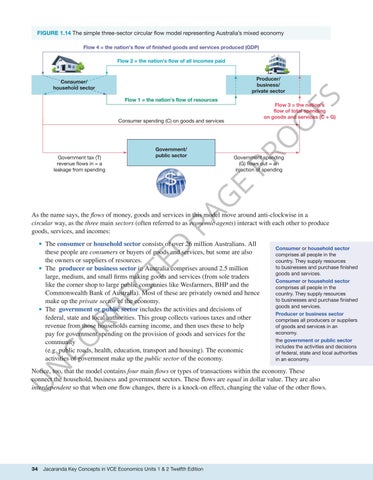“c01ThinkingLikeAnEconomist_PrintPDF” — 2022/7/18 — 23:09 — page 34 — #32
FIGURE 1.14 The simple three-sector circular flow model representing Australia’s mixed economy Flow 4 = the nation’s flow of finished goods and services produced (GDP) Flow 2 = the nation’s flow of all incomes paid
Producer/ business/ private sector
FS
Consumer/ household sector Flow 1 = the nation’s flow of resources
Flow 3 = the nation’s flow of total spending on goods and services (C + G)
O PR
Government/ public sector
Government spending (G) flows out = an injection of spending
PA
G
E
Government tax (T) revenue flows in = a leakage from spending
O
Consumer spending (C) on goods and services
As the name says, the flows of money, goods and services in this model move around anti-clockwise in a circular way, as the three main sectors (often referred to as economic agents) interact with each other to produce goods, services, and incomes:
D
• The consumer or household sector consists of over 26 million Australians. All
N
CO RR EC
TE
these people are consumers or buyers of goods and services, but some are also the owners or suppliers of resources. • The producer or business sector in Australia comprises around 2.5 million large, medium, and small firms making goods and services (from sole traders like the corner shop to large public companies like Wesfarmers, BHP and the Commonwealth Bank of Australia). Most of these are privately owned and hence make up the private sector of the economy. • The government or public sector includes the activities and decisions of federal, state and local authorities. This group collects various taxes and other revenue from those households earning income, and then uses these to help pay for government spending on the provision of goods and services for the community (e.g. public roads, health, education, transport and housing). The economic activities of government make up the public sector of the economy.
Consumer or household sector comprises all people in the country. They supply resources to businesses and purchase finished goods and services. Consumer or household sector comprises all people in the country. They supply resources to businesses and purchase finished goods and services. Producer or business sector comprises all producers or suppliers of goods and services in an economy. the government or public sector includes the activities and decisions of federal, state and local authorities in an economy.
U
Notice, too, that the model contains four main flows or types of transactions within the economy. These connect the household, business and government sectors. These flows are equal in dollar value. They are also interdependent so that when one flow changes, there is a knock-on effect, changing the value of the other flows.
34
Jacaranda Key Concepts in VCE Economics Units 1 & 2 Twelfth Edition





















































